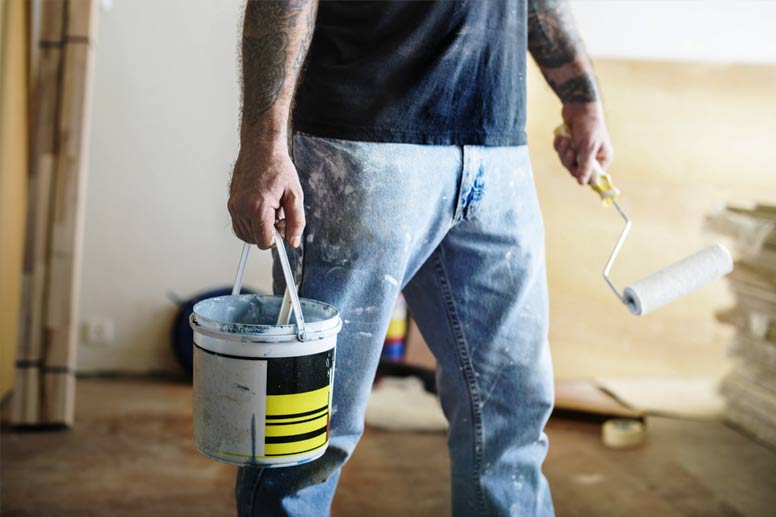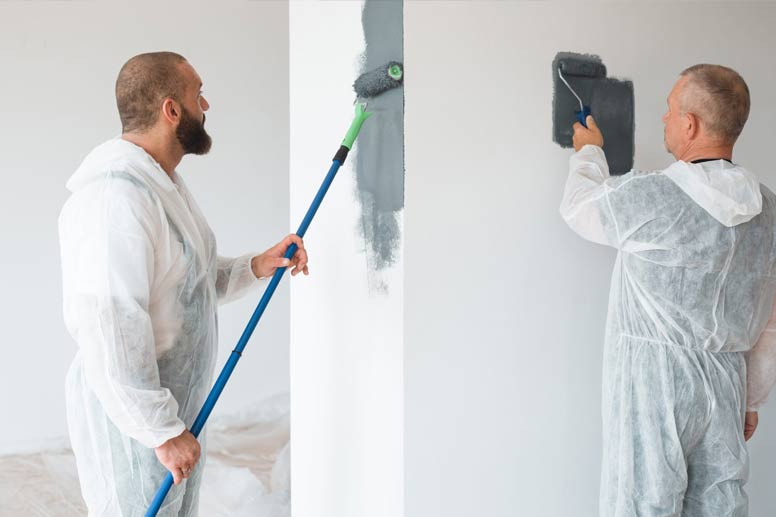How to Get Your Painting Business Insurance in 2025?

Table of Contents
- Why Do You Need Painting Business Insurance?
- Types of Painting Business Insurance You Need
- How Much Does Painting Insurance Cost?
- How to Get Insurance for Your Painting Business
- Finding the Best Painting Business Insurance Quotes
- Tips for Lowering Insurance Costs
- Painting Insurance by State
- Why State Rules Matter
- Tools to Manage Your Painting Business
- Final Thoughts
In this guide, we’ll walk you through how to get your painting business insurance in 2025. You’ll learn about the types of coverage you need, how to compare policies, and how to navigate state-specific requirements.
By the end, you’ll have the tools and knowledge to protect your livelihood, meet legal standards, and earn your clients’ trust with confidence.
Running a painting business is full of opportunities, but success also requires preparation. Accidents like a spilled paint can, a ladder mishap, or an employee injury can happen when you least expect them.
That’s where painting business insurance comes into play—it’s your safety net to handle the unexpected.
Here in the United States, rules and requirements for small business insurance vary by state. Some states mandate certain types of coverage, like workers’ compensation for businesses with employees, while others leave it up to individual contractors.
Regardless of your location, having proper insurance is a critical step for long-term success. Not only does it protect you from costly claims, but it also builds trust with clients who want assurance that they’re hiring a professional.
Plus, many larger projects and government contracts require proof of insurance to even bid.
Let’s dive into it!
Why Do You Need Painting Business Insurance?
Insurance is your safety net, plain and simple. As a painting contractor, you face risks every day—whether it’s a ladder tipping over, paint spilling on valuable furniture, or an employee getting hurt on the job. Without insurance, just one costly accident could not only drain your savings but also threaten the future of your business.
If you’re repainting a client’s living room, and a gallon of paint accidentally topples over, spilling all over their brand-new hardwood floors. Without painter liability insurance, you’d have to cover the repair costs yourself—potentially thousands of dollars.
That kind of unexpected expense could put a serious dent in your finances, or worse, drive you out of business. But with the right insurance policy, the damages would be covered, allowing you to handle the situation professionally without worrying about the financial fallout.
Having insurance isn’t just about covering accidents. It’s also about peace of mind for you and your clients. Clients are far more likely to trust and hire a professional who’s insured, knowing they’re protected no matter what happens. Insurance isn’t just a business expense. It’s a smart investment in your success and stability.
RELATED ARTICLE: How To Get Your Painting License In The United States?

Types of Painting Business Insurance You Need
Not all insurance is created equal, and choosing the right types of coverage is essential for protecting your painting business.
Here are the most common types of painting contractor insurance you should consider, along with real-world examples to show why they matter:
General Liability Insurance
This is the foundation of any painting business insurance policy. It protects you from property damage, bodily injuries, and legal fees if a client sues for negligence.
For instance, if you accidentally spill paint on a client’s expensive carpet or someone trips over your equipment on-site, general liability insurance would cover the costs.
Many clients won’t even consider hiring you unless you can provide proof of this coverage. It’s a must-have for building trust and securing contracts.
Workers’ Compensation Insurance
If you have employees, this insurance is usually required by law. It covers medical expenses and lost wages for employees injured on the job.
Consider a painter in Florida whose employee fell off a ladder, leading to a $10,000 medical bill. Thanks to workers’ compensation insurance, the business avoided paying that hefty sum out of pocket, allowing them to continue operating without financial strain.
This coverage not only protects your workers but also shields your business from costly lawsuits.
Commercial Auto Insurance
Do you drive to job sites or transport materials in a company vehicle?
Commercial auto insurance is essential. It covers accidents, property damage, and injuries involving your work vehicle.
For example, if your van loaded with supplies gets into a fender bender, this policy will cover the repair costs and any third-party damages, saving you from unexpected expenses that could disrupt your schedule and cash flow.
Tools and Equipment Insurance
Protecting your tools is essential. Tools and equipment insurance covers your gear—like sprayers, ladders, and brushes—against theft, damage, or loss.
For example, if someone breaks into your work van overnight and steals your equipment, replacing everything out of pocket could cost thousands. With the right insurance, you’re covered, so you can quickly replace your tools and get back to work without a major financial setback.
Professional Liability Insurance
Also known as errors and omissions insurance, this coverage handles claims related to mistakes or failures in your services.
For example, a client hires you to paint their home, but a few months later, the paint starts peeling due to improper preparation. If the client sues for damages, professional liability insurance would cover the legal fees and any settlements.
It’s especially important for maintaining your reputation and handling disputes professionally.
RELATED ARTICLE: How To Start A Painting Business In 9 Steps?

How Much Does Painting Insurance Cost?
The cost of insurance for a painting business depends on several factors, including the size of your business, the coverage you need, and your location.
Average Costs:
- General liability insurance: $400–$1,500 per year
- Workers’ compensation: $1,000–$3,000 annually, depending on payroll size
- Commercial auto insurance: $1,200–$2,500 per year
- Tools and equipment insurance: $300–$500 annually
To get the best rates, compare multiple painting business insurance quotes and bundle policies when possible.
Tip! Using tools like our Software for Painting Contractors can help you keep track of your expenses and ensure you’re staying within budget.
RELATED ARTICLE: How Much Do Painters Charge? Painting Pricing Guide
How to Get Insurance for Your Painting Business
Protecting your painting business with the right insurance is a smart move that can save you from unexpected financial headaches. Here’s a step-by-step guide to getting the best coverage for your business:
1. Assess Your Risks
Start by identifying the unique risks your business faces.
Do you tackle large commercial projects where the stakes are higher? Do you have employees who could get injured on the job? If you work on historic homes or high-end properties, consider how damages could escalate.
These details will help you determine what types of insurance you need, such as general liability, workers’ compensation, or tools and equipment insurance.
2. Gather Your Documentation
Before shopping for policies, gather key business details. Insurance companies will ask for information like:
- Your business structure (LLC, sole proprietorship, etc.)
- Your annual revenue and payroll size
- The type and value of your tools and equipment
For example, if your sprayers, ladders, and other tools are worth $10,000, you’ll want to include that in your coverage estimate. Having these details ready will streamline the process and help you get accurate quotes.
3. Shop Around for Quotes
Don’t settle for the first insurance provider you find. Get quotes from at least three companies to compare prices, coverage options, and customer service.
Look for insurers that specialize in painting contractor insurance or have experience working with contractors. Providers like Hiscox or Next Insurance often offer tailored plans for small businesses.
4. Customize Your Policy
Make sure your policy fits your specific needs. For example:
- Solo painters: Focus on general liability insurance and tools coverage.
- Small teams: Include workers’ compensation and commercial auto insurance if you have a work vehicle.
- Large-scale operations: Consider adding professional liability insurance for extra protection.
Avoid overpaying for coverage you don’t need. If you don’t use a vehicle for work, skip commercial auto insurance. If you don’t have employees, workers’ compensation may not apply. Tailoring your policy ensures you’re protected without wasting money.
5. Review and Renew Annually
Your business evolves over time, and your insurance should, too. Review your policy every year to make sure it still fits your needs.
For example, if you’ve hired employees or invested in new equipment, update your coverage to reflect these changes. Staying proactive ensures you’re always protected.
RELATED ARTICLE: How Much Do Painters Make? 2025 Salary Guide

Finding the Best Painting Business Insurance Quotes
Finding the right insurance for your painting business starts with researching providers that specialize in contractor insurance.
Look for companies with strong customer reviews, competitive pricing, and a reputation for responsive customer service. Working with an insurer that’s easy to communicate with can save you time, reduce stress, and help resolve claims quickly.
Don’t settle for the first quote you receive! Request at least three estimates from reputable providers and carefully compare coverage, limits, and exclusions. This will give you a clearer picture of which policy offers the best value for your needs.
Many insurers offer online tools to simplify the process, allowing you to request and compare quotes in just a few clicks.
Tips for Lowering Insurance Costs
Saving money on insurance doesn’t mean sacrificing the coverage your business needs. Here are some practical ways to lower your premiums while staying protected:
- Maintain a Clean Safety Record: Insurers reward businesses with fewer accidents and claims. By prioritizing safety on the job, you’ll not only protect your team but also qualify for premium discounts.
- Bundle Your Policies: Combining general liability, workers’ compensation, and commercial auto insurance with the same provider often results in significant savings. Multi-policy discounts can add up quickly, making this a smart move for most painting businesses.
- Track Your Expenses: Use our Receipt Scanner feature to keep accurate records of your business expenses. By identifying deductible items, you can save money at tax time, which indirectly offsets insurance costs.
Mark, a painter in Michigan, discovered he could save 20% on his insurance premiums by bundling his liability, workers’ compensation, and auto insurance with a single provider. He also implemented a safety protocol for his team, which helped him qualify for additional discounts.
These changes not only lowered his costs but also improved his business operations and professionalism.
Painting Insurance by State
When it comes to painter insurance, the requirements vary by state. Knowing the rules in your area is crucial to staying compliant, protecting your business, and meeting client expectations.
Let’s take a closer look at a few key states:
California
While general liability insurance isn’t required by law in California, it’s often a necessity to land jobs. Many clients won’t hire painters who don’t have liability coverage, as it provides protection against accidents like spilled paint or damaged property.
If you have employees, workers’ compensation insurance is mandatory to cover workplace injuries. California also has strict licensing rules for contractors, and proof of insurance is often part of the licensing process.
Florida
In Florida, liability insurance isn’t legally required for small painting businesses, but it’s highly recommended. It can protect you from lawsuits and boost your credibility with clients.
However, if you employ four or more people, workers’ compensation insurance is required by law. With Florida’s frequent storms and high humidity, property damage claims related to painting are more common, making liability coverage a smart investment.
Michigan
Michigan doesn’t mandate liability insurance for painters, but it’s almost essential for commercial projects, as many contracts require proof of coverage.
If you use a vehicle to transport tools or materials, a commercial auto insurance policy is typically needed.
Workers’ compensation is required if you have employees, and carrying this coverage protects your business from costly claims.
Texas
Texas has relatively relaxed insurance requirements for painting contractors, but liability insurance is still a good idea to protect against unexpected accidents.
Workers’ compensation is optional for most businesses, but offering it can make your company more attractive to employees and clients alike.
New York
In New York, if you have employees, workers’ compensation insurance is required by law. Liability insurance isn’t legally mandated, but it’s practically a necessity if you want to land big residential or commercial projects.
Plus, in a busy urban environment like New York, accidental damage to neighboring properties is more likely, making liability coverage a smart choice to protect your business.
Why State Rules Matter
State insurance requirements aren’t just red tape—they’re tailored to local laws, industry practices, and even climate-related risks.
For example, states like Florida, with higher weather-related risks, often see more liability claims related to storm damage. Always check with your state’s insurance department or contractor board to confirm what’s required.

Tools to Manage Your Painting Business
Running a painting business involves more than just buying insurance. Staying organized and managing projects efficiently can save you time and money.
- Our Invoice Maker helps you create professional invoices and track payments.
- The Estimate app feature ensures you price jobs accurately, which is essential for calculating insurance coverage needs.
- The Client Portal feature lets you communicate with clients and keep track about every project, and the status of every invoice and estimate sent.
Final Thoughts
Getting painting insurance in the United States is a crucial step in protecting your business and ensuring long-term success. From understanding the types of coverage you need to navigating state-specific requirements, the process might seem overwhelming at first. But with the right approach, it’s completely manageable.
Start by assessing the unique risks your business faces—whether it’s property damage, employee injuries, or liability claims. Then, gather the necessary documentation and shop around for the best quotes from reputable providers.
Remember to customize your policy to suit your specific needs. A solo painter’s coverage will look very different from that of a painting company with a large crew. Finally, review your policy annually to ensure it evolves with your growing business.
By following these steps and staying organized with our Software for Painting Contractors, you can secure the insurance you need and focus on what matters most: growing your business and delivering exceptional results for your clients.
Protect your painting business today—get the right insurance and download Invoice Fly App to streamline your operations and stay one step ahead!
